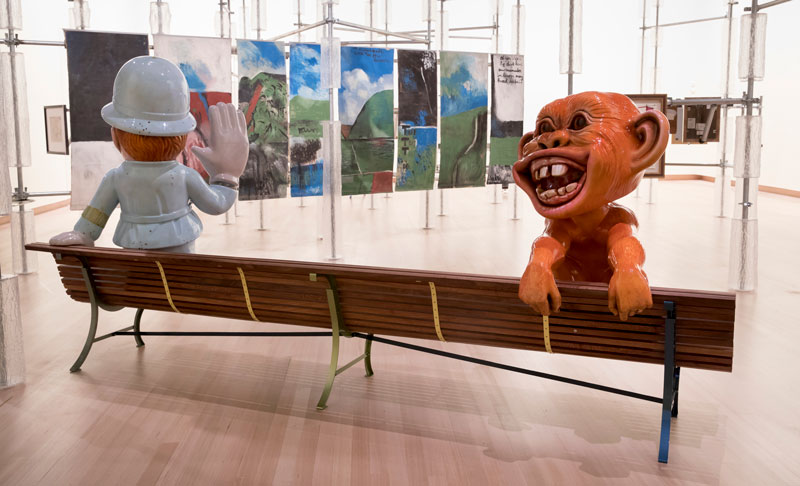
Art has been a sensitive topic for the Museum of New Zealand Te Papa Tongarewa since it opened twenty years ago in 1998. This point of contention might now be resolved with the recent opening of Toi Art, a major architectural renovation that provides a new wing of gallery spaces spanning Te Papa’s fourth and fifth floors. Toi Art features a number of exhibitions with new commissions, of these Michael Parekowhai’s Détour and He Toa Tāera Fashion Activists by the Pacific Sisters are particularly strong. The occasion is added to by the launch of a new publication on Te Papa’s history.
Widely considered as the return of the national art gallery and promoted by Te Papa staff as “a building within a building,” Toi Art is marketed and architecturally conceived as a distinct entity. It is unmistakably a traditional white cube placed within a postmodern black box. For those who were part of establishing Te Papa in the 1990s this shift might represent a regression from the original Te Papa ethos of being an organisation that allows for greater interdisciplinary integration of art, social and natural history collections.
This original vision proved controversial due to the considerable art sector backlash to Te Papa’s inaugural exhibition Parade which featured Colin McCahon’s iconic Northland Panels (1958) in the vicinity of a Kelvinator refrigerator display. In the recently published book Te Papa: Reinventing New Zealand’s National Museum 1998–2018 author Conal McCarthy clarifies that the pairing of these two items is not an entirely accurate description of the exhibition layout. Nevertheless, the idea of mixing high art and common consumer items “became a leitmotif in a torrent of criticism from art critics, art historians and artists.”[1]
Now twenty years on, McCahon’s Northland Panels can be experienced again in Michael Parekowhai’s elaborate installation Détour (2018) which occupies the entrance to Toi Art. In this installation, Parekowhai takes Marcel Duchamp's Boîte‑en‑valise (1961) miniature suitcase‑sized collection as a point of inspiration and has then curated his own selection of artworks from Te Papa’s collection within a forest‑like scaffold structure. The two‑storey construction features work by artists such as Christo, Frances Hodgkins, Claus Oldenburg, Man Ray and Theo Schoon together with Parekowhai’s own sculptures.
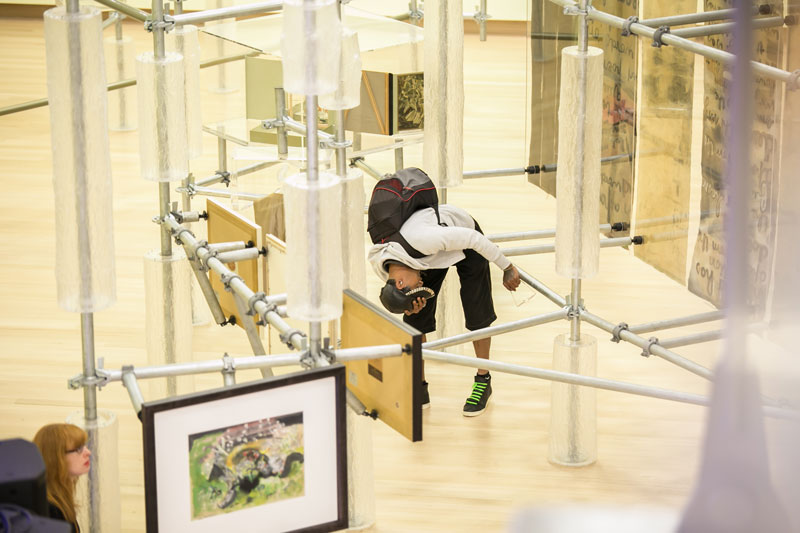
Parekowhai’s work is easily digested on the surface but underneath it has layers of references that are laced with subterfuge and complicity. For instance, the presence of the McCahon’s Northland Panels is prominently featured as the first artwork you see upon entering Toi Art. Nearby are life‑sized fiberglass kitsch bobble head figurines, Constable Plumb Bob (2018) which seems to be waving to McCahon’s work, and Tiki Tour (2018) a monkey‑like character reminiscent of old racist cartoons. The fact that Parekowhai opens Toi Art with this juxtaposition is most certainly a nod to the contentious McCahon versus fridge display at the opening of Te Papa in 1998.
The hang of the Northland Panels also functions to reveal messages by McCahon on the back of the loose canvases which have been hidden to the public until now. One part reads: “The very small is as the very large when its outlines are not seen.” In keeping with McCahon’s words, the play of scale as a commentary on perceptions of value and power is a recurring conceptual thread that can be found running throughout Détour. This message is doubly significant because the Northland Panels were one of the first in a series of large‑scale works painted by McCahon after a trip to the United States in 1958. Of this experience, it has been said that McCahon became inspired by the large works of American abstract expressionists such as Jackson Pollock, Mark Rothko and Willem De Kooning.
Another similar example is the display of a tiny New Zealand flag presented inside a miniature storefront. The little flag is one of many that travelled to the moon on board the Apollo Missions and were then gifted by president Richard Nixon to nations around the world—a symbolic gesture of shared human endeavour while also reminding the world of US technological dominance during the Cold War period. The storefront is an exact 1:1 scale model copied from a Christo drawing, Pink Store Front (Project) (1980), that also features in Détour. This drawing belongs to a body of work that is considered as a pivotal shift in Christo’s practice from his small wrapped objects to large architectural works after he immigrated to the US in 1964, paralleling McCahon’s similar story. The flag displayed in the Christo shop toys with scale as it does the inflation and deflation of ego and ambition, not unlike that of an artist contending with the privilege of being selected by a museum which has a mandate of representing a nation’s identity.
Aside from shifts in scale, the slippery and fragile context of art is also a core conceptual thread not just in relation to Te Papa but art history in general, from Duchamp’s readymades onwards. This is indicated to in an accompanying booklet which features images of Parekowhai’s transparent acrylic display boxes photographed empty and credited as artworks. The Te Papa collection items are then also documented separately such as Man Ray’s Cadeau (replica) (1921). Then on the subsequent page, the collection item is photographed inside the Parekowhai display box with authorship credited to both artists. This may come across as unnecessarily documentation but there is nothing perfunctory about it. Rather it is a wry sleight‑of‑hand that points out that the physical and ideological context of art is a box that simultaneously protects and confines.
Parekowhai also cunningly folds this institutional critique in on itself by meddling with the architecture of Toi Art. To the left of the gallery entrance he has placed a giant arrow that completes the Toi Art curved facade designed to funnel the public into its interior from the busy café area. Just like his acrylic boxes, Parekowhai literally points to the context containing the art and the realisation that Toi Art is an austere white cube within a “family friendly” black box.
Among the first to follow the arrow into this “building within a building” was Prime Minister Jacinda Ardern who was reverently welcomed into Toi Art in fabulous style by the Pacific Sisters, the subject of a major survey show He Toa Tāera Fashion Activists, encompassing the majority of Toi Art’s fourth floor gallery space. The Pacific Sisters also had an important presence at the original Te Papa opening in 1998 with a commissioned work and, I am told by exhibition curator Nina Tonga, that they were the first wahine to speak on the paepae of Te Papa’s Te Marae.
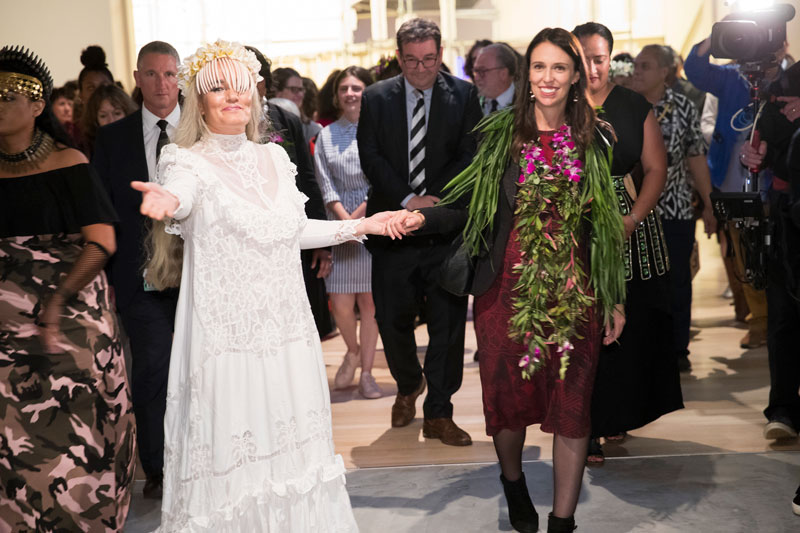
No doubt Ardern would have felt the influence of the Pacific Sisters, as did I and many others of a similar age who were teenagers in the 1990s, because at this time the Sisters were a pivotal cultural movement that permeated the country’s best art, fashion and music. The continuing impact of the Pacific Sisters on more recent generations of Māori and Pacifica artists such as FAFSWAG is clearly apparent and is discussed at length in a brilliant article by Ioana Gordon‑Smith.[2]
They have been influential because they produced sophisticated high art/fashion and pop culture through a multicultural politic that reflected New Zealand’s changing demographics from the 1990s. This political awareness was fused within their bold aesthetic which drew on a vast media‑scape of references and crafted it into something new: ranging from the Afro Futurist aesthetics of Sun Ra, Grace Jones and Parliament Funkadelic; to punk rock and techno rave culture; mixed with Pacific traditions and urban street fashion. This diversity is reflected in the Pacific Sisters’ list of collaborators that encompasses three hundred creative practitioners including a number that are now prominent figures: from musicians DLT and Tim Finn to actor Cliff Curtis and artist John Pule. That said, the nucleus of the Sisterhood is fuelled by nine sustaining key members who all have respected solo careers.[3]
Greeting visitors as they enter the exhibition is a transcendent figure, Kaitiaki with a K; Tāulaolevai Keeper of the water (Tuna) (2017), cloaked in a cape made of VHS tape, that glistens as if ribbons made of obsidian, and adorned with coconut, mother‑of‑pearl shell and pig tusks. This is one of many mannequins displaying exquisite garments within the exhibition that are at times coupled with photography and video throughout four gallery spaces.
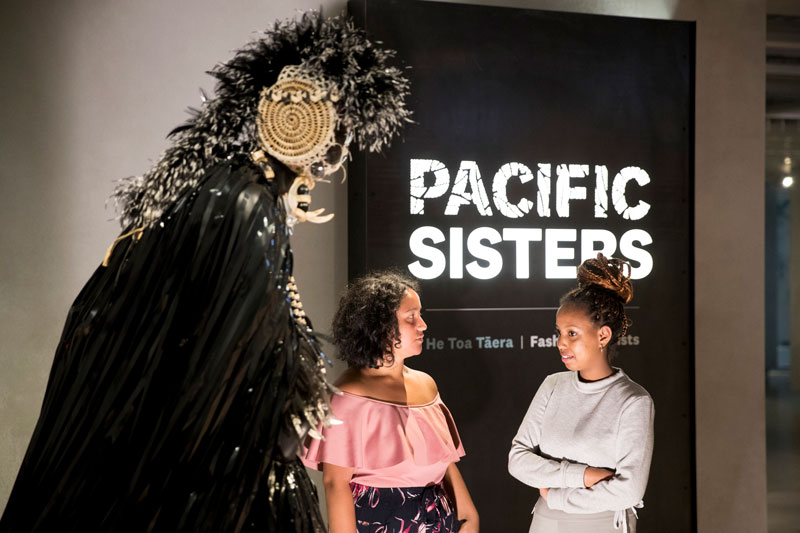
The first gallery introduces visitors to the core members of the Sisterhood, with large photographs of them in costume and motivational quotes that explain their “Koupapa‑driven Frock” ethos. The idea of Koupapa‑driven Frock is described as an emancipatory principle that envisions clothing being more than just decorative adornment. Fashion is seen by them as statements of power and value that can celebrate diverse identities and liberate them from racial and gender discrimination. These principles are embedded within the apparel on display that incorporate everything from plastic cable ties and denim, through to pandanus and tapa cloth.
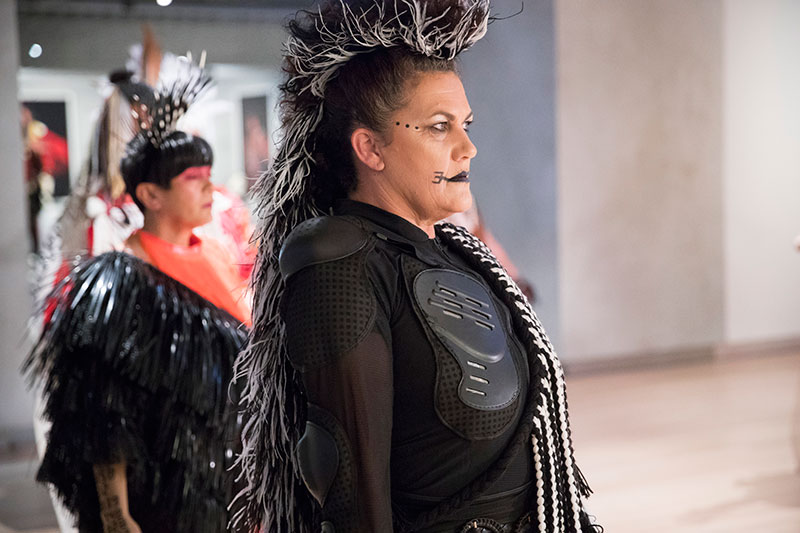
The garments also contain narratives of “women as warriors.” This is particularly illustrated in a gallery dedicated to a performance led by Rosana Raymond in 1996 that tells the story of Ina and Tuna (eel). Told throughout the Pacific, this story of Tuna’s over‑amorous advances towards the beautiful Ina who then turns him into a coconut tree, explains the tree’s origins but also doubles as a tale in which women have transformative agency over other forces. In the video documentation, Tuna is played by an androgynous slithering coconut‑shelled dancer who is effortlessly levelled by the confident Ina performed by Raymond.
Reflecting the fashion activist sentiment, the exhibition as a whole also resists the white cube archetype that preoccupies the Toi Art renovation. Opting instead for concrete rendered walls, reverent lighting and large catwalk inspired plinths to display their work. In fact, it must be said, that the eclectic pan‑indigenous‑urban‑futurist aesthetic of the Pacific Sisters was at home within Te Papa’s original dream. The postmodern black box didn’t threaten these artists who were more than happy in similar environments such as nightclubs, theatres and fashion show runways.
In a small art scene Te Papa is a big target and over time there has been a tendency for the community to overinflate minor issues to a monumental scale. But this battle over context is more than just a high art versus entertainment for the masses paradigm clash. As the Michael Parekowhai and Pacific Sisters exhibitions illustrate, what is really needed for art to flourish is a social context of lively critique that is self‑reflexive, embraces multiplicity, knows its history and is in conversation with a wide array of artists and those from other disciplines. Perhaps now, with Toi Art established, Te Papa can just get on with doing what it has been doing all along and what we need it to continue doing—to be “our place” in its most progressive and engaging sense.
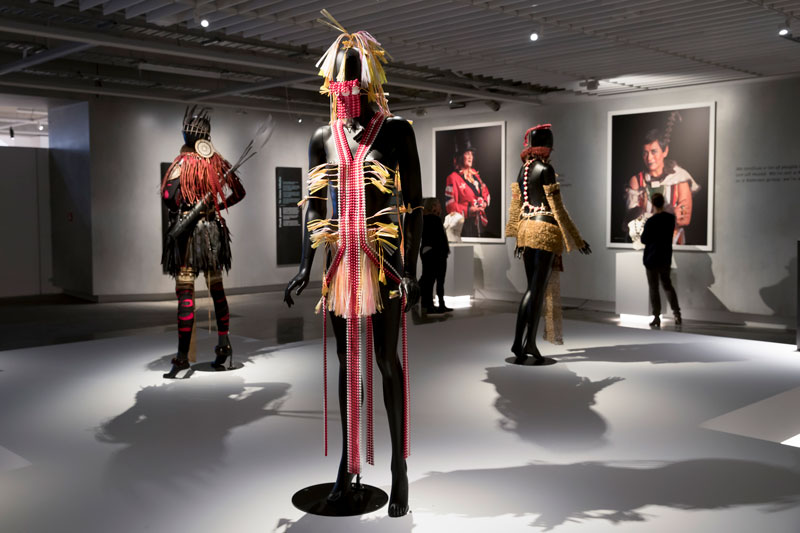
Footnotes
- ^ Conal McCarthy, Te Papa: Reinventing New Zealand’s National Museum 1998–2018, Wellington: Te Papa Press, 2018. p. 104
- ^ See Ioana Gordon-Smith. “From the Margins to the Mainstream,” Pantograph Punch: http://pantograph-punch.com/post/pacific-sisters
- ^ These nine sisters are Lisa Reihana, Rosanna Raymond, Ani O’Neill, Suzanne Tamaki, Selina Haami, Niwhai Tupaea, Henzart @ Henry Ah-Foo Taripo, Feeonaa Wall, and Jaunnie ‘Ilolahia.












